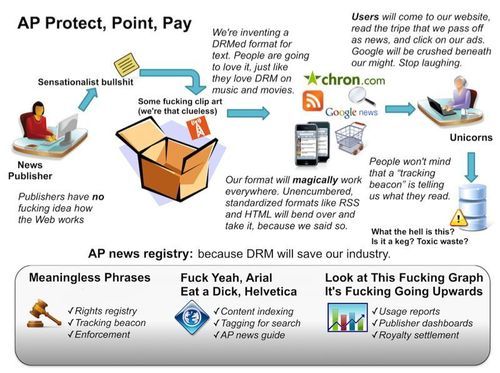AP News introduces new DRM Scheme

The Associated Press last week rolled out its brave new plan to “apply protective format to news.” The AP’s news registry will “tag and track all AP content online to assure compliance with terms of use,” and it will provide a “platform for protect, point, and pay.” That’s a lot of “p”-prefaced jargon, but it boils down to a sort of DRM for news—”enforcement,” in AP-speak.
But how could that possibly work?
It was good enough for music…
Turns out that it won’t, not really, not if the goal is to exercise control over AP content by those not voluntarily disposed to play by the AP’s rules. First, let’s try to make sense of what’s being proposed. According to the AP’s announcement, the news registry it plans to set up relies on a new “microformat,” described thusly:
The microformat will essentially encapsulate AP and member content in an informational “wrapper” that includes a digital permissions framework that lets publishers specify how their content is to be used online and which also supplies the critical information needed to track and monitor its usage.
The registry also will enable content owners and publishers to more effectively manage and control digital use of their content, by providing detailed metrics on content consumption, payment services and enforcement support. It will support a variety of payment models, including pay walls.
To make the system clear, the AP also released this not-in-any-way confusing chart of what it intends to do.
 The “wrappers” and “digital permissions frameworks” that it hopes to implement sound like tough encryption, but they aren’t. Instead, the AP is simply relying on a newly-developed microformat called hNews. It’s a simple HTML-based tagging scheme for marking up news content and making headlines, author names, and permitted uses machine-readable and search-engine friendly. (See an example.) hNews is funded by major foundations, and all of its tools and specs will be released as open-source software.
The “wrappers” and “digital permissions frameworks” that it hopes to implement sound like tough encryption, but they aren’t. Instead, the AP is simply relying on a newly-developed microformat called hNews. It’s a simple HTML-based tagging scheme for marking up news content and making headlines, author names, and permitted uses machine-readable and search-engine friendly. (See an example.) hNews is funded by major foundations, and all of its tools and specs will be released as open-source software.
In what way does this scheme “wrap” and “protect” the news? It doesn’t; it simply marks it up, and adding tags expressing a content creator’s wishes on reuse has no bearing on someone’s rights under US copyright law. What it does do is provide organizations that use hNews a way to release more rights than are granted under copyright—in essence, a sort of “Creative Commons” news license. In fact, hNews’ “rights field” uses ccREL, the Creative Commons Rights Expression Language.
The AP’s news registry will use hNews to embed some kind of Web beacon in news content as well, making it possible to track some uses of the story across the Web. Users who simply copy and paste parts of the story, or those who retype bits of it to use as quotes, or those of simply strip out the tags will of course not end up being tracked.
You’ll be forgiven if you find it difficult to square the reality of hNews with the AP’s pronouncements about it. Ed Felten, the eminent Princeton computer security researcher, couldn’t figure it out, either.
“It was hard to make sense of this, so I went looking for more information,” he wrote on his blog. “AP posted a diagram of the system, which only adds to the confusion—your satisfaction with the diagram will be inversely proportional to your knowledge of the technology… hNews is a handy way of annotating news stories with information about the author, dateline, and so on. But it doesn’t ‘encapsulate’ anything in a ‘wrapper,’ nor does it do much of anything to facilitate metering, monitoring, or paywalls.”
The great difficulty in talking about the AP’s year-long push to stop “misappropriation” of its content is that it has never been quite clear what behavior AP is trying to stop. It’s not targeting Google, as it already has a deal in place with Google to provide full-text feeds of its news stories. It doesn’t appear to be going after small-time bloggers or those who use quotes from AP stories in their work.
But it has pursued a “hot news” case recently (which was just settled), and the AP seems to be signaling its intentions to go after sites that profit from large-scale use of AP headlines without paying for them. How the news registry helps them do this remains unclear, since sites that don’t do what AP wants are unlikely to include its Web beacons.
Is AP going after sites that occasionally quote from its news stories (using proper citation and links)? Such a move seems bizarre on its face—and the AP routinely cites sources of its own, including Ars Technica—but it’s not out of the question. When paidContent’s Staci D. Kramer put the question recently to AP Chairman Dean Singleton, the response was slightly creepy.
“I was a little taken aback when I asked Singleton what would happen to sites like ours: ‘I’ll leave that to the rules of engagement that we’ll be developing’ in coming weeks. Not ‘we’re not after sites like yours’ or ‘we’re looking at flagrant violators.’ And no sign at all that AP will be reaching out beyond its members for input.”
And yet, when we spoke to AP back in June, AP news editor Ted Bridis seemed much more sure of the answer.
OK, we said. How will you define “wholesale theft?” If somebody publishes a paragraph of AP copy with a link to the AP story, will that be theft?
“Not at all,” Bridis replied. “I don’t think AP would have any problem with that.” We didn’t want to give the impression that we were bargaining, but we pressed on as to exactly how one would disturb AP’s comfort zone. Was this about not posting links?
No, Bridis replied. “What I’m talking about, and what has really riled up our internal copyright folks, are the bloggers who take, just paste an entire 800 word story into their blog. They don’t even comment on it. And it happens way more than most people realize.”
But neither hNews nor the news registry will do anything to stop bloggers copying text off a webpage, and they certainly won’t stop people from doing marginal “rewrites” of AP’s work and passing it off as original writeups.
So this all might be about wholesale infringement, or it might be about the “hot news” contained in AP headlines and ledes, or it might be both. But the one thing it isn’t is “clear”—the journalist’s cardinal sin.
hNews looks like a nice way to mark up news, to make it visible to search engines, and to provide useful metadata for those who want to do interesting things with the content. But what it has to do with “wrappers,” “enforcement,” and “protection” is unclear. Reading the AP announcement and the graphic that accompanied it, one is struck by the thought that perhaps the AP has been snookered into believing that it’s getting “DRM for news,” when in reality it’s simply using an open-source news metadata markup language with Creative Commons rights expression.
Certainly, there’s a pretty large contingent of writers in the blogosphere who think the AP is simply misguided, out of touch, or simply stupid. It’s the sort of attitude that leads to mocking graphics which may be uncharitable, but it is quite obvious that hNews and a registry aren’t going to save the traditional news industry without some significant other changes.
Down the road, of course, the AP might go to Congress and ask that whatever tracking and rights system it settles on be given the force of law. It’s not as crazy as it sounds; European publishers already hope to get a law enforcing the Automated Content Access Protocol.
“We need search engines to recognize ACAP as a step towards acknowledging that content providers have the right to decide what happens to their content and on what terms,” said the Chairman of ACAP, Gavin O’Reilly, recently. “The European Commission and other legislators call on our industry constantly to come up with solutions—here we have one and we call upon the regulators to back it up.”
Leave a Reply
You must be logged in to post a comment.




 NoScript extension
NoScript extension
